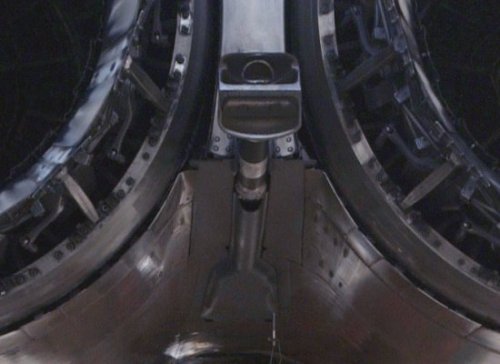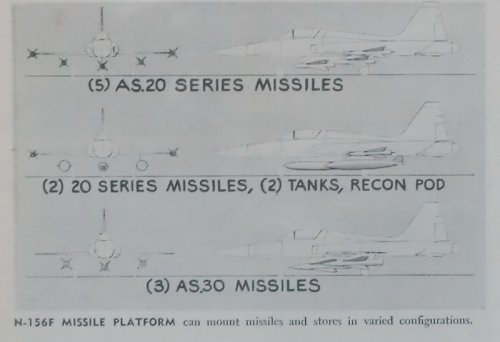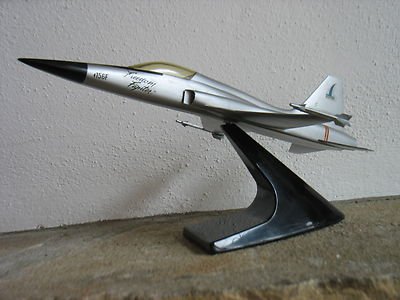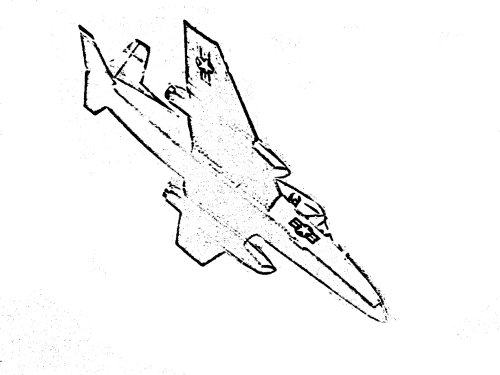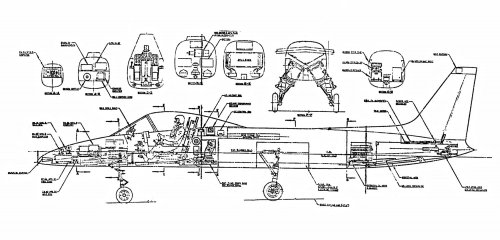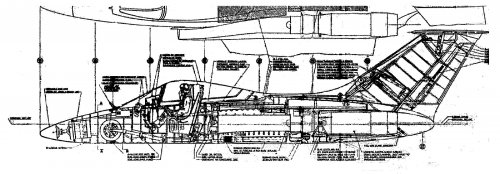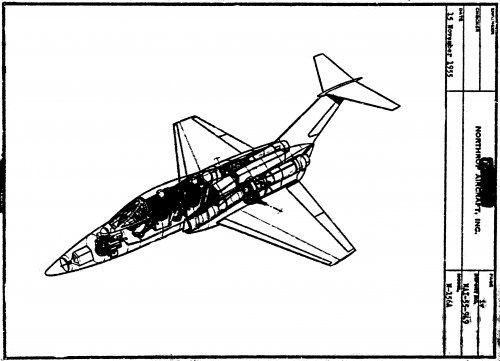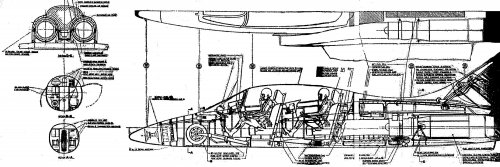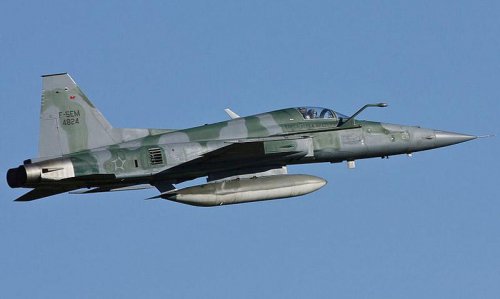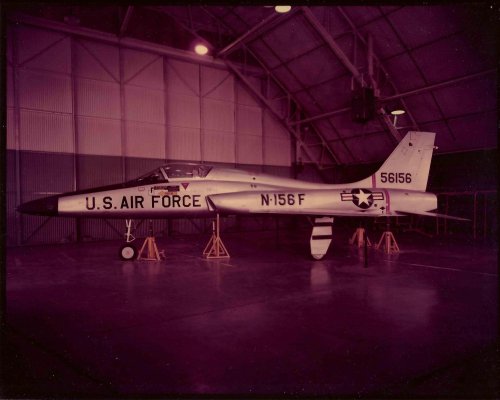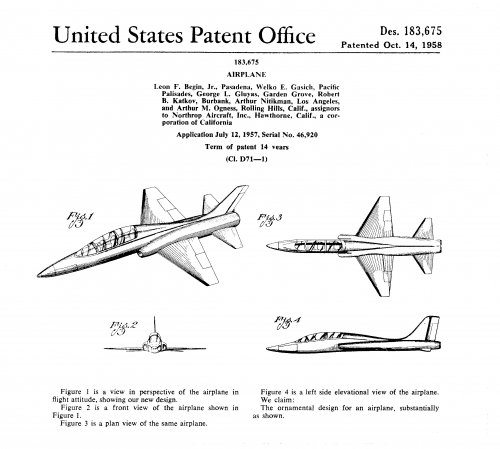You are using an out of date browser. It may not display this or other websites correctly.
You should upgrade or use an alternative browser.
You should upgrade or use an alternative browser.
N-156: Evolution of the Northrop F-5
- Joined
- 11 March 2006
- Messages
- 8,664
- Reaction score
- 3,513
Attachments
- Joined
- 25 June 2009
- Messages
- 14,102
- Reaction score
- 4,194
aim9xray said:To better catch the arresting cable/chain at the departure end of the runway, of course.
Jemiba said:Even the F-22 has it
Thanks guys. I wasn't aware of that kind of appendix on Air Force aircraft.
- Joined
- 11 March 2006
- Messages
- 8,664
- Reaction score
- 3,513
Proposal by Northrop of the N-156F as an all-weather system, using the Hughes Taran fire control
system and Nord Aviation missiles, designated "Rapiere", in the air-to-air role the AA.20 was envisaged,
for air-to-ground the AS.20 or AS.30.
(From Aviation Week June 1960, sorry for the low quality of the drawing, not much better in the article)
system and Nord Aviation missiles, designated "Rapiere", in the air-to-air role the AA.20 was envisaged,
for air-to-ground the AS.20 or AS.30.
(From Aviation Week June 1960, sorry for the low quality of the drawing, not much better in the article)
Attachments
- Joined
- 21 May 2006
- Messages
- 2,833
- Reaction score
- 1,912
Very interesting find JamibaIt is sometimes overlooked that the U.S. military (and to some degree U.S. industry!) were impressed and influenced by some of these early 'compact' missile systems such as the SS.10, AS.20 missiles, for the Americans seemed to lack knowledge or interest in small tactical missiles for some time! Or could this just have been due to export potential of U.S. platforms to nations who preferred French weaponry :Jemiba said:Proposal by Northrop of the N-156F as an all-weather system, using the Hughes Taran fire control
system and Nord Aviation missiles, designated "Rapiere", in the air-to-air role the AA.20 was envisaged,
for air-to-ground the AS.20 or AS.30.
(From Aviation Week June 1960, sorry for the low quality of the drawing, not much better in the article)
system, nor that of the air-to-air variant/adaption of the AS.20/AS.30 family!!"Rapiere"
Model of Northrop N156F manufactured by Topping found on eBay.
URL:
http://www.ebay.com/itm/TOPPING-MODEL-OF-NORTHROP-N156F-VTG-RARE-COND-VG-/121079641128?pt=LH_DefaultDomain_0&hash=item1c30e8b428
Might be of interest to a collector.
URL:
http://www.ebay.com/itm/TOPPING-MODEL-OF-NORTHROP-N156F-VTG-RARE-COND-VG-/121079641128?pt=LH_DefaultDomain_0&hash=item1c30e8b428
Might be of interest to a collector.
- Joined
- 29 January 2008
- Messages
- 886
- Reaction score
- 1,777
Some early N156 drawings. Sorry for poor quality, these came off old microfiche. More to follow.
Attachments
- Joined
- 27 December 2005
- Messages
- 16,873
- Reaction score
- 21,513
- Joined
- 22 January 2006
- Messages
- 4,088
- Reaction score
- 1,636
RAP,
Many thanks for sharing this extremely interesting drawing. Now, we have a pretty interesting collectio of Northrop designs to trace back the evolution of ideas about light supersonic fighter/trainer concept.
Many thanks for sharing this extremely interesting drawing. Now, we have a pretty interesting collectio of Northrop designs to trace back the evolution of ideas about light supersonic fighter/trainer concept.
RAP's drawings from microfilm are clearly for a carrier-based aircraft, showing the catapult attachment and the tailhook. The widely separated engines, however, would have probably been judged to be unacceptable to the Navy for the one-engine-inoperative situation. Hence the follow-on T-tail design with the engines in nacelles on the side of the fuselage.
- Joined
- 29 January 2008
- Messages
- 886
- Reaction score
- 1,777
Here is some info from the N-156 study these drawings came from.
Introduction
This report is a brief analysis covering the performance of a supersonic lightweight aircraft especially adapted to operation from short airfields or small aircraft carriers. Combat ceiling is 57,000ft, rate of climb at sea level of 46,000ft per minute, combat speed of M. 1.41 at 35,000ft. Take-off weight less that 10,000 lbs. Planned powerplant General Electric X-104 equipped with afterburner.
Configuration utilizing nacelle mounted engines was selected because it affords (1) armament separation from engines; (2) good pressure recovery for the engines; (3) adequate moment of inertia about the roll axis for good dynamic stability; (4) airplane balance characteristics allowing long tail length for good longitudinal stability and low trim drag; (5) power plant flexibility is such that a prototype development can be started immediately with Armstrong Siddeley Viper, ASV-5 engines.
Armament
Fire control system- MK16 Mod 2 automatic lead computing system. Two T160 20mm guns, 150 rounds each. Tip pods with 74 2in FFAR rockets or 38 2.75in FFAR rockets. 2 Sparrow or 4 sidewinder missiles. Mark 12 special store.
Carrier Suitability
Suitable for CVA and CVL carriers. Limited capacity of the catapults on escort carriers would require some modification in order to launch the N-156. Two 1000lb JATO bottles could provide additional lift.
Lightweight Supersonic Trainer
Conversion of the basic fighter into a two-place, dual controlled, supersonic trainer will have approximately the same performance. This would give the Navy a very versatile airplane that could be used for pilot training at supersonic speeds in level flight, multi-jet engine and instrument training, carrier indoctrination, VIP transportation and perhaps a two-place interceptor and/or ground support airplane.
Introduction
This report is a brief analysis covering the performance of a supersonic lightweight aircraft especially adapted to operation from short airfields or small aircraft carriers. Combat ceiling is 57,000ft, rate of climb at sea level of 46,000ft per minute, combat speed of M. 1.41 at 35,000ft. Take-off weight less that 10,000 lbs. Planned powerplant General Electric X-104 equipped with afterburner.
Configuration utilizing nacelle mounted engines was selected because it affords (1) armament separation from engines; (2) good pressure recovery for the engines; (3) adequate moment of inertia about the roll axis for good dynamic stability; (4) airplane balance characteristics allowing long tail length for good longitudinal stability and low trim drag; (5) power plant flexibility is such that a prototype development can be started immediately with Armstrong Siddeley Viper, ASV-5 engines.
Armament
Fire control system- MK16 Mod 2 automatic lead computing system. Two T160 20mm guns, 150 rounds each. Tip pods with 74 2in FFAR rockets or 38 2.75in FFAR rockets. 2 Sparrow or 4 sidewinder missiles. Mark 12 special store.
Carrier Suitability
Suitable for CVA and CVL carriers. Limited capacity of the catapults on escort carriers would require some modification in order to launch the N-156. Two 1000lb JATO bottles could provide additional lift.
Lightweight Supersonic Trainer
Conversion of the basic fighter into a two-place, dual controlled, supersonic trainer will have approximately the same performance. This would give the Navy a very versatile airplane that could be used for pilot training at supersonic speeds in level flight, multi-jet engine and instrument training, carrier indoctrination, VIP transportation and perhaps a two-place interceptor and/or ground support airplane.
- Joined
- 29 January 2008
- Messages
- 886
- Reaction score
- 1,777
More N-156 drawings. Identified as Lightweight Navy Fighter-Interceptor. Study dated 9/19/55. Some info from the study:
Supersonic, extreme lightweight (10,100lbs) fighter. Combat ceiling 61,100ft, M.1.51, combat radius 450 nautical miles. Designed specifically to operate off CVE-105 class carriers. This class carrier could operate a squadron of 16 N-156's.
Armament consisted of 2 Sidewinders in frangible tip pods. Alternate armament 48 (24 per wing tip pod) 2in Gimlet rockets.
Again, apologize for quality, all the info and drawings is coming off old microfilm.
This proposal was short-lived as the entire jeep carrier class was mothballed. Northrop: An Aeronautical History, p.174.
Supersonic, extreme lightweight (10,100lbs) fighter. Combat ceiling 61,100ft, M.1.51, combat radius 450 nautical miles. Designed specifically to operate off CVE-105 class carriers. This class carrier could operate a squadron of 16 N-156's.
Armament consisted of 2 Sidewinders in frangible tip pods. Alternate armament 48 (24 per wing tip pod) 2in Gimlet rockets.
Again, apologize for quality, all the info and drawings is coming off old microfilm.
This proposal was short-lived as the entire jeep carrier class was mothballed. Northrop: An Aeronautical History, p.174.
Attachments
- Joined
- 28 November 2006
- Messages
- 703
- Reaction score
- 692
RAP said:More N-156 drawings. Identified as Lightweight Navy Fighter-Interceptor. Study dated 9/19/55. Some info from the study:
Supersonic, extreme lightweight (10,100lbs) fighter. Combat ceiling 61,100ft, M.1.51, combat radius 450 nautical miles. Designed specifically to operate off CVE-105 class carriers. This class carrier could operate a squadron of 16 N-156's.
Armament consisted of 2 Sidewinders in frangible tip pods. Alternate armament 48 (24 per wing tip pod) 2in Gimlet rockets.
Again, apologize for quality, all the info and drawings is coming off old microfilm.
This proposal was short-lived as the entire jeep carrier class was mothballed. Northrop: An Aeronautical History, p.174.
Some question regarding this variant of N-156:
- What were its dimensions (what is in the microfilm is for me completely unreadable)?
- Was the radar in the nose a ranging radar or rather a seach radar?
- Was N-156 to be armed with guns?
Piotr
- Joined
- 29 January 2008
- Messages
- 886
- Reaction score
- 1,777
Hi Petrus-
1) The microfilm is very hard to read. The dimensions are approximately: wingspan 26ft, length 34ft, height 12ft.
2) The report does not specify any gun armament and it does not appear any are on the inboard drawing.
3) In regards to the radar, again the report offers no specifics but the inboard drawing indicates it was a search radar. Specific type is not identified (or at least not that I can read).
Hope this was helpful.
1) The microfilm is very hard to read. The dimensions are approximately: wingspan 26ft, length 34ft, height 12ft.
2) The report does not specify any gun armament and it does not appear any are on the inboard drawing.
3) In regards to the radar, again the report offers no specifics but the inboard drawing indicates it was a search radar. Specific type is not identified (or at least not that I can read).
Hope this was helpful.
- Joined
- 29 January 2008
- Messages
- 886
- Reaction score
- 1,777
N-156A- Supersonic USAF Trainer, Nov. 15, 1955. Again, apologize for poor quality drawing. Very old microfiche and tail end of drawing was 'blacked out', I assume by age and fading of the image.
Attachments
- Joined
- 26 January 2011
- Messages
- 2,223
- Reaction score
- 590
Some F-5Es had a fillet added to the front of their tails and others didn't. Was it merely national choice or was there some other factor as to why it was chosen by some air forces and not others?
- Joined
- 29 January 2008
- Messages
- 886
- Reaction score
- 1,777
The dorsal fin was optional and can be seen on both F-5E's and F's. It improved directional stability by increasing keel area. Countries that had this fitted were: Brazil, Chile, Indonesia, Kenya, Mexico, Morocco, Singapore, Sudan and Tunisia.
- Joined
- 12 May 2008
- Messages
- 226
- Reaction score
- 443
- Joined
- 29 January 2008
- Messages
- 886
- Reaction score
- 1,777
- Joined
- 2 August 2006
- Messages
- 3,202
- Reaction score
- 1,301
RAP said:The dorsal fin was optional and can be seen on both F-5E's and F's. It improved directional stability by increasing keel area. Countries that had this fitted were: Brazil, Chile, Indonesia, Kenya, Mexico, Morocco, Singapore, Sudan and Tunisia.
It does increase the area a little, but what it really does is act like a "strake" for the vertical tail. As the aircraft yaws, you'll get a vortex off of it on the leeward side, making the vertical tail more effective in yaw.
- Joined
- 26 January 2011
- Messages
- 2,223
- Reaction score
- 590
I wonder though, why some air forces chose it and others didn't? It wasn't retrofitted either, as far as I can find. So, what ever advantage it offered wasn't considered sufficient to change matters.
- Joined
- 2 August 2006
- Messages
- 3,202
- Reaction score
- 1,301
Kadija_Man said:I wonder though, why some air forces chose it and others didn't? It wasn't retrofitted either, as far as I can find. So, what ever advantage it offered wasn't considered sufficient to change matters.
I'll have to go back and find some of my books, but of course there was a good reason for it, or they wouldn't have done it. It was one of the last modifications they made before closure of the line IIRC.
- Joined
- 25 June 2009
- Messages
- 14,102
- Reaction score
- 4,194
RAP said:Patent drawings for PD-2878D.
Nice, but please be accurate. The designation in your post differs from the one in your image. Which is the right one? Thanks for clarifying.
- Joined
- 26 January 2011
- Messages
- 2,223
- Reaction score
- 590
[Source]In 1962, however, the Kennedy Administration revived the requirement for a low-cost export fighter, selecting the N-156F as winner of the F-X competition on 23 April 1962 subsequently becoming the "F-5A", being ordered into production in October that year
Does anybody know what the other contenders for the F-X competition were?
- Joined
- 25 June 2009
- Messages
- 14,102
- Reaction score
- 4,194
Kadija_Man said:Does anybody know what the other contenders for the F-X competition were?
Was it really called the "F-X" competition?
I thought this code specifically designated the later "F-15 Eagle" competition.
- Joined
- 26 May 2006
- Messages
- 33,449
- Reaction score
- 13,474
Kadija_Man said:[Source]In 1962, however, the Kennedy Administration revived the requirement for a low-cost export fighter, selecting the N-156F as winner of the F-X competition on 23 April 1962 subsequently becoming the "F-5A", being ordered into production in October that year
Does anybody know what the other contenders for the F-X competition were?
Hi Kadija,
the other tenders to F-X or MAP competition were Lockheed CL-457 and also I suggest the
North American Rapier.
- Joined
- 6 November 2010
- Messages
- 4,591
- Reaction score
- 4,024
The (F-X??) competition was for a low-cost export fighter. The North American F-108 Rapier, had it been built, would not have been cheap. An unlikely contender.hesham said:the other tenders to F-X or MAP competition were Lockheed CL-457 and also I suggest the
North American Rapier.
What is your source for the CL-457 as a contender?
Similar threads
-
-
-
-
Lockheed CL-1200 / X-27 Lancer
- Started by overscan (PaulMM)
- Replies: 83
-
EC-121 Proliferation?
- Started by Rule of cool
- Replies: 41

